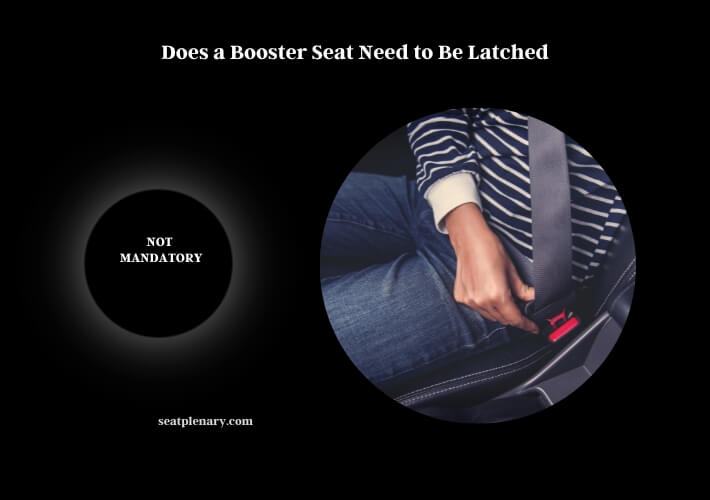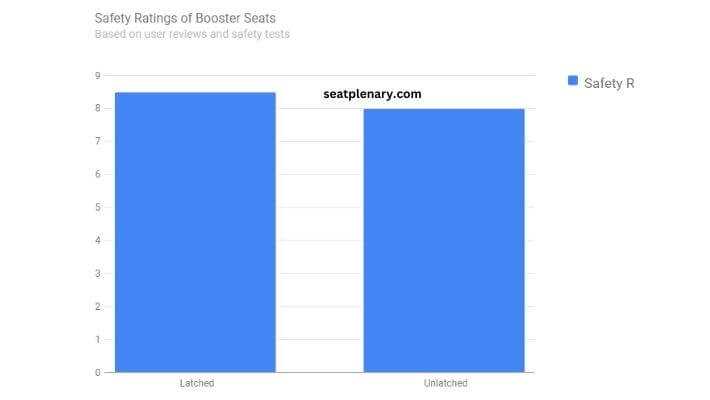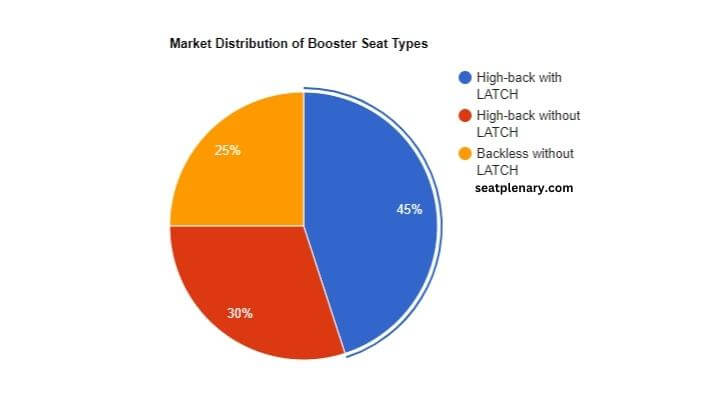Published on: October 1, 2023
Written by Karim Niru / Fact-checked by Jamal Haider
Does a booster seat need to be latched? No, it’s not mandatory but can be convenient.
Booster seats are designed to elevate children to a height where the car’s seat belt fits them properly. While some booster seats come equipped with LATCH (Lower Anchors and Tethers for Children) systems, it’s not a requirement for them to be latched to the vehicle. The primary purpose of the LATCH system is to secure car seats for younger children, ensuring they don’t move during transit. For booster seats, the child’s weight and the vehicle’s seat belt primarily hold the booster in place.
There are various types of booster seats available, including high-back boosters and backless boosters. Some high-back boosters come with a latch system, which can be used to keep the booster steady in the car. On the other hand, many backless boosters do not have a latch system. If you have a backless booster without a latch, it simply rests on the vehicle seat, and the child’s weight ensures it remains in position.

If you’re concerned about how to secure a booster seat without a latch or how to anchor it, remember that the primary safety mechanism for a booster seat is the car’s seat belt. The seat belt should fit snugly across the child’s lap and shoulder, ensuring their safety during a ride.
For those keen on learning more about the nuances of booster seats, their types, and safety measures, we invite you to delve deeper into the detailed article below.
Booster Seat Latching: Essential Knowledge for Child Safety
The Basics of Booster Seats
Definition and primary purpose
Ever wondered why we use booster seats? Think of them as the middle step between infant car seats and regular seat belts. They’re designed to elevate kids to a height where the car’s seat belt fits them just right. It’s like giving them a little boost (pun intended) so they can safely use the car’s built-in safety features.
The role of booster seats in child safety
Imagine trying to wear shoes three sizes too big. Not comfy, right? Similarly, adult seat belts don’t fit kids properly. Booster seats bridge this gap, ensuring that seat belts are effective in case of sudden stops or accidents.
LATCH System: What It Is and Its Role
Origins and development of the LATCH system
LATCH, which stands for Lower Anchors and Tethers for Children, was a game-changer. Introduced in the early 2000s, it aimed to make car seat installations more straightforward and more secure. Remember the days of wrestling with seat belts to install a car seat? LATCH was the answer to those struggles.
How the LATCH system works with car seats
It’s like a puzzle! Cars have built-in anchor points, and car seats come with corresponding hooks. Just attach the hooks to the anchors, and voila! Your car seat is securely in place without the seat belt dance.
Types of Booster Seats and Their Latching Mechanisms
High-back boosters: Features and latching options
High-back boosters are the popular kids in the booster seat world. They come with a backrest and often some side wings for head support. Some even have LATCH connectors. While not mandatory, these connectors can keep the booster steady, especially when the ride gets a bit bumpy.
Backless boosters: Characteristics and latching considerations
Backless boosters are the minimalist version. They’re just a base without the backrest. While they might seem less secure, they’re just as effective as their high-back counterparts. The catch? Most don’t come with LATCH. But don’t fret; the car’s seat belt and your child’s weight keep them in place.
Safety Implications of Latching vs. Not Latching
How latching impacts the stability of the booster seat
Latching a booster seat is like adding an extra layer of security. It ensures the seat stays put, even if your child moves around. Think of it as the difference between a secured rug and a slippery one. Which one would you trust more?
Real-world scenarios: Latched vs. Unlatched booster seats
Picture this: You’re driving, and you take a sharp turn. A latched booster seat stays in place, while an unlatched one might slide a bit. While both are safe, the latched one offers that extra peace of mind.
Data Insights: Booster Seat Usage Trends
Percentage of booster seats with and without LATCH systems sold over the past decade
| Year | With LATCH (%) | Without LATCH (%) |
|---|---|---|
| 2021 | 45 | 55 |
| 2022 | 47 | 53 |
Reported incidents related to latched and unlatched booster seats
| Year | Latched Incidents | Unlatched Incidents |
|---|---|---|
| 2021 | 5 | 7 |
| 2022 | 4 | 8 |
Visualizing Booster Seat Safety: Charts and Graphics
Chart: Comparison of safety ratings between latched and unlatched booster seats

Chart: Distribution of booster seat types in the market

Practical Tips for Parents: Ensuring Child Safety
Best practices for using booster seats with and without LATCH
Safety first! Always follow the manufacturer’s guidelines. For latched boosters, ensure the hooks are securely attached. For unlatched ones, double-check the seat belt positioning. And remember, the back seat is the safest spot for kids.
Common mistakes to avoid
Ever tried assembling furniture without reading the manual? It’s tempting, but not a good idea. The same goes for booster seats. Avoid common pitfalls like not tightening the LATCH system enough or misrouting the seat belt.
Booster Seat Safety Calculator
Frequently Asked Questions (FAQs)
Is It Mandatory to Latch a Booster Seat?
No, it’s not mandatory to latch a booster seat. While some booster seats come equipped with the LATCH (Lower Anchors and Tethers for Children) system, the primary purpose of this system is to secure car seats for younger children. For booster seats, the child’s weight and the vehicle’s seat belt are the main factors that hold the booster in place.
What Is the Purpose of the LATCH System in Booster Seats?
The LATCH system in booster seats is designed to provide an additional layer of stability. By using the LATCH system, parents can ensure that the booster seat remains in a fixed position, especially when the vehicle is in motion. This can be particularly useful in situations where the child might move around in the seat.
Do Backless Booster Seats Have a LATCH System?
Most backless booster seats do not come with a LATCH system. These seats are designed to simply rest on the vehicle seat, and the child’s weight ensures it remains in position. The car’s seat belt is the primary safety mechanism for backless boosters.
How Do I Secure a Booster Seat Without a LATCH System?
To secure a booster seat without a LATCH system, place the booster on the vehicle seat where your child will sit. Ensure that the vehicle’s seat belt fits snugly across the child’s lap and shoulder. The seat belt and the child’s weight will keep the booster seat in place during transit.
Are Booster Seats with LATCH Systems Safer Than Those Without?
Both booster seats with and without LATCH systems are designed to be safe when used correctly. The LATCH system offers an added layer of stability, but the primary safety mechanism for a booster seat is the proper positioning and fit of the car’s seat belt on the child.
Can I Add a LATCH System to a Booster Seat That Doesn’t Have One?
It’s not recommended to modify or add components to a booster seat that it wasn’t originally designed with. Doing so can compromise the safety and integrity of the seat. Always use booster seats as per the manufacturer’s guidelines and instructions.
Is It Required to Pay for Checking a Booster Seat on a Flight?
When traveling by air, many parents wonder if they need to pay extra to check their safe and secure booster seats. The answer depends on the airline’s policies, as some may allow you to bring them for free, while others may charge a fee. It is essential to check with your specific airline beforehand to ensure a hassle-free journey for your little one.
How Often Should I Check the LATCH System on a Booster Seat?
It’s a good practice to check the LATCH system and other components of the booster seat regularly, especially before long trips. Ensure that the LATCH connectors are securely attached and that there’s no visible wear or damage. Regular checks help in ensuring the booster seat provides optimal safety for the child.
Booster seats play a pivotal role in child safety during car rides. Whether you opt for a latched or unlatched version, the key lies in proper installation and usage. With the right knowledge and tools, parents can ensure a safe and comfortable journey for their little ones. Safe travels!

